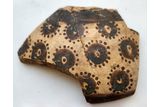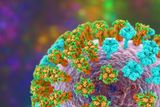The Earth Is Round, and Is Also a Shifting, Squashed Spheroid



A first launch of the Long March 12A Chinese state-owned reusable rocket reached orbit late Monday, but attempted recovery of the first stage downrange failed.
The post Long March 12A reaches orbit in first reusable launch attempt, but landing fails appeared first on SpaceNews.

Electrochemical impedance spectroscopy (EIS) provides valuable insights into the physical processes within batteries – but how can these measurements directly inform physics-based models? In this webinar, we present recent work showing how impedance data can be used to extract grouped parameters for physics-based models such as the Doyle–Fuller–Newman (DFN) model or the reduced-order single-particle model with electrolyte (SPMe).
We will introduce PyBaMM (Python Battery Mathematical Modelling), an open-source framework for flexible and efficient battery simulation, and show how our extension, PyBaMM-EIS, enables fast numerical impedance computation for any implemented model at any operating point. We also demonstrate how PyBOP, another open-source tool, performs automated parameter fitting of models using measured impedance data across multiple states of charge.
Battery modelling is challenging, and obtaining accurate fits can be difficult. Our technique offers a flexible way to update model equations and parameterize models using impedance data.
Join us to see how our tools create a smooth path from measurement to model to simulation.
An interactive Q&A session follows the presentation.

Noël Hallemans is a postdoctoral research assistant in engineering science at the University of Oxford, where he previously lectured in mathematics at St Hugh’s College. He earned his PhD in 2023 from the Vrije Universiteit Brussel and the University of Warwick, focusing on frequency-domain, data-driven modelling of electrochemical systems.
His research at the Battery Intelligence Lab, led by Professor David Howey, integrates electrochemical impedance spectroscopy (EIS) with physics-based modelling to improve understanding and prediction of battery behaviour. He also develops multisine EIS techniques for battery characterisation during operation (for example, charging or relaxation).

The post Physics-based battery model parameterization from impedance data appeared first on Physics World.









Deal deepens contractor’s push into space-based sensing and optical communications.
The post CACI to buy space technology firm ARKA for $2.6 billion appeared first on SpaceNews.

Tory Bruno, the longtime chief executive of United Launch Alliance, is leaving the joint venture for another opportunity.
The post United Launch Alliance chief Tory Bruno resigns appeared first on SpaceNews.

A new measurement by CERN’s ATLAS Collaboration has strengthened evidence that the masses of fundamental particles originate through their interaction with the Higgs field. Building on earlier results from CERN’s CMS Collaboration, the observations suggest that muon–antimuon pairs (dimuons) can be created by the decay of Higgs bosons.
In the Standard Model of particle physics, the fermionic particles are organized into three different generations, broadly in terms of their masses. The first generation comprises the two lightest quarks (up and down), the lightest lepton (the electron) and the electron neutrino. The second includes the strange and charm quarks, the muon and its neutrino; and the third generation the bottom and top quarks, the tau and its neutrino. In terms of the charged fermions, the top quark is nearly 340,000 times heavier than the lightest – the electron.
All of the quarks and leptons have both right- and left-handed components, which relate to the direction of a particle’s spin relative to its direction of motion (right-handed if both directions are aligned; left-handed if they are anti-aligned).
Right- and left-handed particles are treated the same by the strong and electromagnetic forces, regardless of their generation in the Standard Model. The weak force, however, only acts on left-handed particles.
In the 1960s, Steven Weinberg uncovered a theoretical solution to this seemingly bizarre asymmetry. He proposed that the Higgs field acts as a bridge between each particle’s left- and right-handed components, in a way that respects the Standard Model’s underlying symmetry. This interaction causes the particle to constantly flip between its two components, creating a resistance to motion that can be perceived as mass.
However, this deepens the mystery. According to Weinberg’s theory, higher-mass particles must interact more strongly with this Higgs field – but in contrast, the strong and electromagnetic forces can only differentiate between these particles according to their charges (colour and electrical). The question is how does Higgs field can distinguish between particles in different generations if their charges are identical?
Key to solving this mystery will be to observe the decay products of Higgs bosons with different interaction strengths. For stronger interactions, corresponding to heavier generations, these decays should become far more likely.
In 2022, both the ATLAS and CMS collaborations did just this. Through proton–proton collision experiments at CERN’s Large Hadron Collider (LHC), the groups independently observed Higgs bosons decaying to tau–antitau pairs. This relatively common process occurred at the same rate as predicted by theory.
A year earlier, similar experiments by the CMS collaboration probed the second generation by observing muon–antimuon pairs from the decays of Higgs bosons. This rarer event occurs in just 1 in 5000 Higgs decays.
In their latest study, the ATLAS collaboration have now reproduced this CMS result independently. They collided protons at about 13 TeV and observed muon–antimuon pairs in the same range of energies predicted by theory.
Through the improvements they offer on the earlier CMS analysis, these new results bring dimuon observations to a statistical significance of 3.4σ. This is well below the 5σ standard required for the observation to be considered a discovery, so more work is needed.
The research could also provide guidance in the search for much rarer Higgs interactions that involve first-generation particles. This includes decay electron–positron pairs, originating from Higgs bosons which decay in just 1 in 200 million cases.
The research is described in Physical Review Letters.
The post Higgs decay to muon–antimuon pairs sheds light on the origin of mass appeared first on Physics World.

21 December 2025, Čakovec — Genesis Space Flight Laboratories launches its Microgravity Research Rideshare Program, making it easier and more affordable to conduct retrievable experiments in space. From now on, […]
The post Microgravity Research Rideshare Program Launched by Genesis, Experiments from €6K to and from SSO appeared first on SpaceNews.


The time is ripe to end the “Wolf Amendment,” a congressional bar inhibiting civil collaboration between the United States and China in space. The impetus for the law was noble — an attempt to challenge human rights conditions in China and prevent leaks of space-related technology — but in practice the ban harms our security […]
The post It’s time to unburden space cooperation with China appeared first on SpaceNews.

New Mexico — December 22, 2025 — Desert Works Propulsion (DWP) today announced the expansion of its domestic electric propulsion development and testing capabilities to address growing demand for advanced […]
The post Desert Works Propulsion expands U.S. ion propulsion capability through domestic manufacturing partnership and test capacity growth appeared first on SpaceNews.

Japan’s flagship H3 rocket suffered an issue with its second stage late Sunday resulting in the loss of the Michibiki 5 (QZS-5) navigation satellite.
The post Japan’s H3 suffers second-stage anomaly, QZS-5 satellite lost appeared first on SpaceNews.
